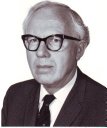Sylvan Greenlee
American chemist and U.S. co‑pioneer of epoxy resins. His work at Devoe & Raynolds in the late 1930s–1940s produced early patents and industrial practices that helped launch epoxy technology across coatings, adhesives, and electrical insulation.

Historical Context
The emergence of epoxy resins is rooted in parallel developments in Europe and the United States during the late 1930s. While Pierre Castan advanced epoxide–diphenol resins in Switzerland, Sylvan Greenlee pursued closely related work at Devoe & Raynolds in the U.S., establishing epoxies as high‑performance thermosets that could be tailored via curing chemistry for coatings and adhesives. The convergence of these efforts created the technological and commercial platform that propelled epoxy into post‑war industry.
Research Focus and Early Discoveries
Greenlee’s research centered on the synthesis and curing behavior of epoxide‑bearing resins derived from epichlorohydrin and phenolic precursors—systems conceptually aligned with today’s diglycidyl ether backbones (e.g., (DGEBA and related structures). A key insight was that, when crosslinked with appropriate hardeners (notably anhydrides and amines), these resins formed rigid, chemically resistant networks suitable for demanding service environments.
The early Devoe & Raynolds work emphasized protective coatings and structural bonding: formulations were tuned by varying resin equivalents, hardener types, stoichiometry, accelerators, and fillers to balance pot life, cure profile, film integrity, and corrosion resistance. These principles continue to underpin modern epoxy formulation practice.
Patents and Industrialization
Through the early 1940s, Greenlee and coworkers pursued patent protection covering resin synthesis routes and curing systems suited to industrial coatings and adhesives. These filings—assigned to Devoe & Raynolds—were among the earliest U.S. disclosures consolidating epoxy chemistry into practical product families. As production know‑how accumulated, the technology transitioned from laboratory to plant scale, enabling reliable performance in primer systems, structural adhesives, and insulating varnishes.
Late 1930s: Laboratory development of epoxide‑based resins at Devoe & Raynolds (U.S.).
Early 1940s: Patents filed on epoxy formulations and curing systems (U.S. assignments to Devoe & Raynolds).
Post‑war period: Scale‑up and adoption in protective coatings, adhesives, and electrical applications.
Chemistry and Curing (Technical Overview)
Greenlee’s epoxy formulations exemplified the now‑classical architecture of epoxide‑rich resins crosslinked with nucleophilic curing agents. Representative curing systems include:
- Amines: aliphatic and cycloaliphatic amines for ambient to moderate‑temperature cures; aromatic amines for elevated‑temperature, high‑Tg performance.
- Anhydrides: slow‑cure, low‑exotherm systems valued in electrical casting and chemically aggressive environments; often initiated by tertiary amines/imidazoles.
- Thiol‑epoxy: fast, low‑temperature cures for rapid repair and assembly (trade‑off in ultimate thermal resistance).
- Catalytic homopolymerization: epoxy–epoxy cure via Lewis acids/bases (e.g., BF3 complexes, imidazoles), useful for low‑viscosity impregnation and certain electrical varnishes.
Process control—stoichiometry, exotherm management in thick sections, and staged post‑cure—was fundamental to achieving design Tg, adhesion, and chemical resistance in service.
Industrial Impact and Legacy
Greenlee’s work helped validate epoxy resins as versatile, engineerable materials systems for high‑demand environments. The U.S. industrial pathway he helped establish—alongside European developments—led to broad adoption of epoxies in corrosion‑resistant coatings, structural adhesives, composite matrices, and electrical encapsulants. The formulation logic and processing heuristics from that era remain embedded in contemporary epoxy technology.
Related People and Pages
References & Further Reading
- Historical overview: Wikipedia — Epoxy (History).
- Industry/contextual background on early commercialization (U.S. coatings and adhesives): trade catalogues and mid‑century coatings handbooks (add specific citations if you have scans).
- Reference handbooks:
- Lee, H., & Neville, K. (1967). Handbook of Epoxy Resins. McGraw‑Hill. Google Books
- Selected library records for early epoxy literature: National Library of Australia — epoxy references
- Standards context (testing of cured epoxies): ASTM D638 (tensile), D790 (flexural), D695 (compressive), D256 (Izod) — see the testing section on the site’s About page.
Note: If you have specific U.S. patent numbers or archival documents for Greenlee’s filings at Devoe & Raynolds, we can append a primary‑source bibliography here.
Have primary documents related to Sylvan Greenlee’s early epoxy patents? Please contact us via the contact page.